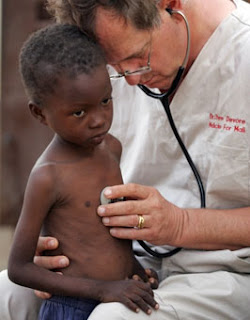
The first photograph is of a typical operating room or procedure room in a typical doctor's office or hospital in the United States. There are various screens hanging from the ceiling, an operating table, shelves full of supplies, and machinery to monitor vital signals. In this photograph, the photographer seems to be trying to portray the cleanliness of a medical room and the various technologies that are used in these types of rooms in the U.S. or other countries that have advanced medical systems. The stark white floor stands out, as well as the steel and off-white appliances that represent the medical technology in place in the room. The photograph is very impersonal, and uses the clean lines of the room to portray a serious and sterile environment. As far as the photograph goes, the rule of thirds is applied well as the table designates the bottom third of the photograph, and the beginning of the ceiling designates the top third of the photograph. The rule of the thirds in the other direction isn't as clear, as the table is centered in the middle of the photograph, but I still think that the clarity is good and the photograph is pleasing to the eye.

The second photograph portrays an operating room being used by two surgeons to operate on a patient. Immediately, it is easy to see that this room is far less advanced as far as technology compared to the first photograph. The lack of computer monitors and screens in the photograph is the most obvious difference in this room. It seems to be a much more elementary operating room that would be located in a country with a more developing medical system and less advanced technology. The subjects are centered again in the middle of the picture so the rule of thirds isn't followed very well in that sense, but the horizontal parts of the picture are divided into three basic sections, with the top of the operating table designating the bottom third, the surgeons in the middle portion, and the bottom of the light beginning the top third of the picture. The lighting in the picture is a little dark, but I think it helps with the message of the photograph and the feeling that the operating room is supposed to convey.

This picture displays a different type of medical "office" located in Africa. It displays a traditional healer treating a patient with some kind of plant or root. The setting is obviously completely different from the past two photographs, and it is clear that this is a completely different type of medicine than in the previous photographs. It offers an insight into the world of traditional medicine that is still often practiced in developing countries in the face of various illnesses and medical issues. As far as the photograph quality goes, it is a clear photograph that includes a lot of emotion and has a lot of story behind it. The rule of thirds is followed vertically, as the people are in the two side thirds and the middle third is the space between them.

This last photograph depicts a doctor that is listening to the chest of a young African boy from a developing part of the continent. It is clear that the boy's stomach appears distended and he doesn't have a shirt on, which indicates poverty in the developing world. The doctor appears to be with some sort of organization visiting the country to offer medical assistance to the natives. The photographer is attempting to portray despair and poverty with the little boy, and extreme focus and concentration in the face of the doctor. The rule of thirds is used because the stethoscope against the boy's chest is off-center, and he makes up the third that is furthest to the left in the picture. Overall, its a great picture portraying intense emotions with a potentially moving story behind it.
Overall, the photographs included in this post do a great job of portraying medical technology in a visual way. Each of the photos conveys incredibly different emotions, and each captures a different type of moment or scene. The photographs go from a highly advanced and technological operating room, to a doctor listening to a young boy's heart beat in the field in a developing country in Africa. The stark contrast between the first picture and the last picture provides insight into the differences in medical technology between different areas of the world. This post follows my blog nicely in that it progresses from the advanced technology of the United States to the medical technology of the developing world.
No comments:
Post a Comment